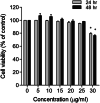Antibacterial and antioxidant effect of ethanol extracts of Terminalia chebula on Streptococcus mutans
- PMID: 34184430
- PMCID: PMC8638286
- DOI: 10.1002/cre2.467
Antibacterial and antioxidant effect of ethanol extracts of Terminalia chebula on Streptococcus mutans
Abstract
Objective: Dental caries is a high prevalent chronic bacterial infectious disease caused by plaque, a bacterial colony deposited on tooth surfaces and gum tissues. Streptococcus mutans is a primary cariogenic bacterium commonly found in the human oral cavity. Oral hygiene products containing antibacterial ingredients can be helpful in caries management. In this study, we investigated the anticaries mechanism of the ethanol extract of Terminalia chebula (EETC) on S. mutans and suggest its possible application as a functional ingredients for oral hygiene products.
Materials and methods: The EETC was prepared from the Terminalia chebula fruit. Disk diffusion, minimum inhibitory concentration (MIC), minimum bactericidal concentration (MBC), and colony forming unit (CFU) were analyzed to observe the antibacterial activity of EETC. The glucan formation was measured using the filtrate of bacterial culture medium and sucrose. Gene expression was analyzed using RT-PCR. Cytotoxicity was analyzed using the MTT assay. The radical-scavenging activities of DPPH and ABTS were also tested to verify the antioxidant activity of EETC.
Results: The antibacterial activity of the EETC was explored through a disc diffusion analysis and CFU measurement. EETC treatment decreased insoluble glucan formation and gene expression of glycosyltransferase B (gtf B), glycosyltransferase C (gtf C), glycosyltransferase D (gtf D), and fructosyltransferase (ftf). The MIC and MBC of EETC on S. mutans were not cytotoxic to gingival fibroblasts. In addition, we observed DPPH and ABTS-radical scavenging activities of EETC.
Conclusions: These results indicate that the antibacterial and antioxidant effects of EETC may contribute to oral hygiene products for dental caries management.
Keywords: Streptococcus mutans; dental caries; ethanol extract of Terminalia chebula; plaque.
© 2021 The Authors. Clinical and Experimental Dental Research published by John Wiley & Sons Ltd.
Conflict of interest statement
The authors have no conflict of interest to disclose.
Figures




Similar articles
-
An in vitro study to determine the effect of Terminalia chebula extract and its formulation on Streptococcus mutans.J Contemp Dent Pract. 2014 May 1;15(3):278-82. doi: 10.5005/jp-journals-10024-1528. J Contemp Dent Pract. 2014. PMID: 25307806
-
Use of ethanol extracts of Terminalia chebula to prevent periodontal disease induced by dental plaque bacteria.BMC Complement Altern Med. 2017 Feb 16;17(1):113. doi: 10.1186/s12906-017-1619-1. BMC Complement Altern Med. 2017. PMID: 28202081 Free PMC article.
-
Effectiveness of mouthrinse formulated from ethanol extract of Terminalia chebula fruit on salivary Streptococcus mutans among 12 to 15 year old school children of Belgaum city: a randomized field trial.J Indian Soc Pedod Prev Dent. 2012 Jul-Sep;30(3):231-6. doi: 10.4103/0970-4388.105016. J Indian Soc Pedod Prev Dent. 2012. PMID: 23263427 Clinical Trial.
-
Triphala in prevention of dental caries and as an antimicrobial in oral cavity- a review.Infect Disord Drug Targets. 2015;15(2):89-97. doi: 10.2174/1871526515666150513105009. Infect Disord Drug Targets. 2015. PMID: 25966965 Review.
-
D-Tagatose: A Rare Sugar with Functional Properties and Antimicrobial Potential against Oral Species.Nutrients. 2024 Jun 19;16(12):1943. doi: 10.3390/nu16121943. Nutrients. 2024. PMID: 38931297 Free PMC article. Review.
Cited by
-
RNA-Seq Reveals Protective Mechanisms of Mongolian Medicine Molor-Dabos-4 on Acute Indomethacin-Induced Gastric Ulcers in Rats.Genes (Basel). 2022 Sep 27;13(10):1740. doi: 10.3390/genes13101740. Genes (Basel). 2022. PMID: 36292625 Free PMC article.
-
Effects of Dietary Terminalia chebula Extract on Growth Performance, Immune Function, Antioxidant Capacity, and Intestinal Health of Broilers.Animals (Basel). 2024 Feb 28;14(5):746. doi: 10.3390/ani14050746. Animals (Basel). 2024. PMID: 38473130 Free PMC article.
-
Studies on In Vitro Antimicrobial, Anticancer, and Anti-oxidative Inflammatory Response of Methanolic Tuber Extracts Derived From Terminalia chebula.Cureus. 2024 Jul 5;16(7):e63930. doi: 10.7759/cureus.63930. eCollection 2024 Jul. Cureus. 2024. PMID: 39109124 Free PMC article.
-
Terminalia Chebula Extract Replacing Zinc Oxide Enhances Antioxidant and Anti-Inflammatory Capabilities, Improves Growth Performance, and Promotes Intestinal Health in Weaned Piglets.Antioxidants (Basel). 2024 Sep 5;13(9):1087. doi: 10.3390/antiox13091087. Antioxidants (Basel). 2024. PMID: 39334746 Free PMC article.
-
Study of Cytotoxic and Antibacterial Activity of Ag- and Mg-Dual-Doped ZnO Nanoparticles.ChemistryOpen. 2024 Mar;13(3):e202300093. doi: 10.1002/open.202300093. Epub 2023 Nov 13. ChemistryOpen. 2024. PMID: 37955867 Free PMC article.
References
-
- Brand‐williams, W. , Cuvelier, M. E. , & Berset, C. (1995). Use of a free radical method to evaluate antioxidant activity. LWT‐Food Science and Technology, 28(1), 25–30.
-
- Caufield, P. W. (2005). Dental caries: An infectious and transmissible disease where have we been and where are we going? The New York State Dental Journal, 71(2), 23–27. - PubMed
-
- Duchin, S. , & van Houte, J. (1978). Relationship of Streptococcus mutans and lactobacilli to incipient smooth surface dental caries in man. Archives of Oral Biology, 23(9), 779–786. - PubMed
-
- Fujishima, K. , Kawada‐Matsuo, M. , Oogai, Y. , Tokuda, M. , Torii, M. , & Komatsuzawa, H. (2013). dpr and sod in Streptococcus mutans are involved in coexistence with S. sanguinis, and PerR is associated with resistance to H2O2 . Applied and Environmental Microbiology, 79(5), 1436–1443. - PMC - PubMed
Publication types
MeSH terms
Substances
LinkOut - more resources
Full Text Sources
Medical

